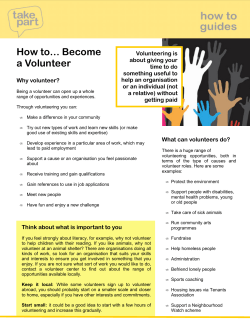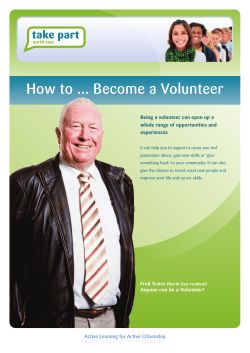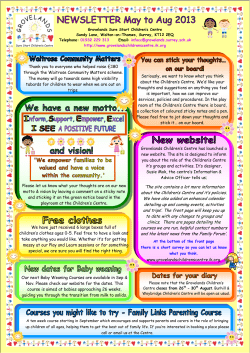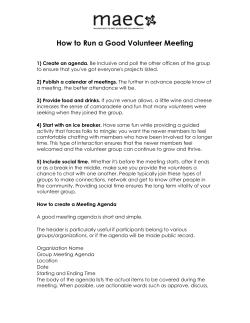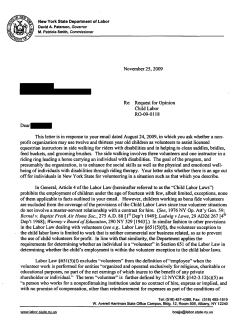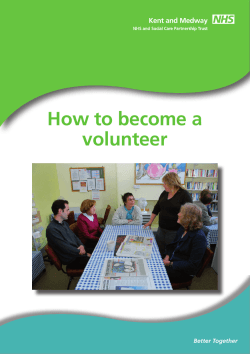
What kind What is family of world do
BUILDING BLOCKS FOR FAMILY VOLUNTEERING KEY RESOURCES FOR FAMILIES What is family volunteering? Learning about the different benefits and opportunities of volunteering together What kind of world do you want? Discovering the types of issues that interest your family What do you like to do? Making it work for you. Finding activities that are right for everyone Exploring questions and considerations around family volunteering FRANÇAIS BUILDING BLOCKS FOR FAMILY VOLUNTEERING KEY RESOURCES FOR FAMILIES What is family volunteering? Family volunteering involves more than one person in a household or extended family, from different generations volunteering together. Family volunteering activities can be as varied as serving food at a food bank, dropping off warm clothes during the holidays, reading to senior citizens, planting a community garden or walking animals at an animal shelter. A common concern around family volunteering is that with so many varying commitments, a busy family cannot find time to volunteering together. Contrary to this perspective, volunteering can be a very flexible activity and there are many opportunities to volunteer in a way that is convenient for a family’s schedule. A family can volunteer on one single day over a holiday, during a festival or summer vacation. A family can even work volunteering into their regular schedule by making a few extra sandwiches together and dropping them off at a shelter. The web resources and books below provide more information around family volunteering. WEB RESOURCES What’s your VQ? Volunteer Canada and Manulife Financial recently developed the Volunteer Quiz. The VQ identifies six types of volunteers in Canada: Cameo, Groupie, Juggler, Rookie, Roving Consultant, and Type A. Using the VQ, families can discover their personal volunteer types and then find volunteer opportunities customized to their type and interests. www.getvolunteering.ca has a section under “I want” where you can click on “My kids to learn early that it’s good to help.” Here you will find an online storybook that introduces the concept of family volunteering and directs families to a matching tool. Volunteer Canada has a study that provides information about family volunteering, including benefits, barriers and models. Points of Light Institute has a research report that highlights the impact of family volunteering on families. Generation On provides information, project ideas, guides and resources around family volunteering catered to kids, teens, parents, teachers and organizations. Get Involved highlights the year round opportunities for family volunteering. Serviceleader.org profiles a few resources around family volunteering, youth engagement and tips around family volunteering. Doing Good Together has FAQ’s, tips for starting out and benefits of family volunteering. 2 TALKING TO YOUR KIDS ABOUT VOLUNTEERING BOOKS Raising Charitable Children by Carol Weisman, F.E. Robbins & Sons Press, 2006. In this book, Weisman shares real-life stories collected from all over the world of how parents, grandparents, aunts, uncles, teachers, scout leaders, friends, next door neighbors, and her own family have either initiated or supported ways to teach children how to give back to those in need. After each of the stories, Weisman offers specific steps to help anyone translate these ideas into action. The Littlest Volunteers, by Danielle Speckhart, published by the Oranges and Short Hills, New Jersey, 2007. This book is a fun and interactive way to introduce children to volunteerism. The benefits of volunteering include: building self-confidence, teaching responsibility and appreciating one’s community. The Littlest Volunteers reinforces many important values including compassion, empathy and generosity as children follow the exciting adventures of Annie and her friends. The Giving Book: Open the Door to a Lifetime of Giving by Ellen Sabin. Watering Can, 1st Edition, 2004. This book is a unique, interactive process that allows parents, teachers and friends to help children understand giving and participate in a stimulating experience. The book combines colourful illustrations and entertaining narrative with fun learning activities. The book helps them record their ideas, dreams and wishes for the world -making them the authors of their stories and creating a “scrapbook” of their journey into compassion, philanthropy and the power of their actions. HOME FRANÇAIS BUILDING BLOCKS FOR FAMILY VOLUNTEERING KEY RESOURCES FOR FAMILIES What kind of world do you want? DISCOVERING THE TYPES OF ISSUES THAT INTEREST YOUR FAMILY... re you concerned about people who don’t have A enough to eat? re you sensitive about the emotional wellbeing A of the terminally ill in hospitals? re you worried about clean water in your A local river? re you concerned for the wellbeing of animals A in your community? Check out these resources for additional ideas around issue areas and opportunities. WEBSITE What’s your VQ? Volunteer Canada and Manulife Financial recently developed the Volunteer Quiz. The VQ identifies six types of volunteers in Canada: Cameo, Groupie, Juggler, Rookie, Roving Consultant, and Type A. Using the VQ, families can discover their personal volunteer types and then find volunteer opportunities customized to their type and interests. Volunteer Family highlights a diversity of issue areas that families might be interested in, all linked to books and web resources. Points of Light Foundation provides a list of 50 children and family volunteer ideas categorized according to issue areas. Doing Good Together profiles a series of issue areas that families may be interested in exploring. BOOKS The Busy Family’s Guide to Volunteering, by Jenny Friedman, Robins Lane Press, 2003. Describes hundreds of volunteer opportunities for families, including projects involving animals, children, the elderly, the environment, cultural organizations and political campaigns. 3 HOME FRANÇAIS BUILDING BLOCKS FOR FAMILY VOLUNTEERING KEY RESOURCES FOR FAMILIES What do you like to do? FINDING ACTIVITIES THAT ARE RIGHT FOR EVERYONE... D o you like walking dogs? You can walk dogs at an animal shelter There are many activities that may interest your family and many of which can be developed for different age groups. The resources below provide some information and options. WEBSITE D o you like playing cards? You can play cards with senior citizens at a retirement home What’s your VQ? Volunteer Canada and Manulife Financial recently developed the Volunteer Quiz. The VQ identifies six types of volunteers in Canada: Cameo, Groupie, Juggler, Rookie, Roving Consultant, and Type A. Using the VQ, families can discover their personal volunteer types and then find volunteer opportunities customized to their type and interests. Generation On offers a variety of projects and activities that your family may be interested in exploring. Family Volunteering: The Ties that Bind has a section of possible family volunteering activities that can be used to brainstorm with your family. D o you like gardening? You can contact a neighbourhood charity with a garden plot to see if they would like some help in the spring. D o you like baking? You can bake some cookies with your family and drop them off at a shelter 4 The Lions Club provides a family volunteering activity list. Volunteer Spot offers a list of family friendly volunteer opportunities from A to Z. BOOKS Doing Good Together: 101 Easy, Meaningful Service Projects for Families, Schools and Communities. By Jenny Friedman and Jolene Roehlkepartain. Free Spirit Publishing, 2010. Doing Good Together answers the growing demand for family volunteerism with hands-on service projects focused on easing poverty, promoting literacy, supporting the troops, helping the environment, and more. Each of the 101 self-contained projects provides an overview, time requirements, materials list, step-by-step instructions, debriefing questions, recommended books for kids and teens, and ideas for extending the activity. HOME FRANÇAIS HOME BUILDING BLOCKS FOR FAMILY VOLUNTEERING KEY RESOURCES FOR FAMILIES Making it work for you If you have found yourself thinking about volunteering with your family, but you are not sure what to expect or even what questions to ask an organization, review this sheet for useful tips. You may wish to meet with a couple of different organizations and ask these questions, so as to best identify an organization that fits with your family’s interests. PREVIOUS EXPERIENCE WITH FAMILY VOLUNTEERS as the organization been involved family volunteers in H the past? Ask them about their experience. They may have lessons learned or interesting perspectives to share with you. Are there growth opportunities available for family members volunteering with the organization? SCHEDULING AND FLEXIBILITY hat kind of hours and what level of flexibility will the W organization have? Will the organization be open to different scheduling options (occasional/fixed schedule)? Are there opportunities to volunteer on evenings and weekends? Can any volunteering be done at home? ACTIVITY IDEAS rganizations may offer different activity options for families. O Find out about the possible opportunities available. istinct activities for youth or children in a family – D family volunteering opportunities may be more appealing to youth if activities are available which are unique to their age group. enerational pairing – Different families can be paired G together around a variety of tasks. This can be a fun exchange for children or youth, providing them with an opportunity to work with other people of a similar age. roup activities – There are a number of group G opportunities that can be made available by an organization to a family. This can sometimes be a more favourable option, as it can require less coordination since parent figures can be directly involved with supervising their family members. ross-Generational pairing – Volunteering can be a way C to bring different family members together. Grandparents can be involved in volunteering activities with their grandchildren. Aunts or Uncles with their nieces or nephews. There are many possible opportunities and arrangements that can be both fun and promote family bonding. 5 cont’d FRANÇAIS HOME BUILDING BLOCKS FOR FAMILY VOLUNTEERING KEY RESOURCES FOR FAMILIES GENERATIONS TOGETHER sk about what policies or structure an organization has in place to A supervise children. Is there a minimum age requirement for volunteers, and will younger children be accepted if supervised by an adult? Is there childcare provided during activities, or supervision of children by a trained staff member? Can activities be modified to suit young children? VOLUNTEER MANAGEMENT POLICIES While there may be many forms or interviews that are part of the process, it is not meant to be unfriendly but rather is often required to keep volunteers, staff and everyone safe. ou may wish to hear about the types of volunteer management Y policies an organization has in place: olunteer assignment – is there a specific position assignment or V description? rientation/training – what kind of orientation or training program is O involved with the volunteer program? For more information on family volunteering and to explore tools and resources for organizations, visit Building Blocks for Family Volunteering: Tools and Resources for Organizations Volunteer Canada, Manulife Financial and GetInvolved have partnered to help connect volunteers and organizations through a matching tool available at www.getinvolved.ca. Here you will be taken through a series of steps to identify your family’s interests; skills and experience; and location. You can select matches for: Anyone Youth Group By checking off the Group option, your family can view volunteer opportunities that may be family friendly in your community. Enjoy and happy volunteering! Acknowledgements upervision – who will be responsible for supervision? Will the S parents be responsible for supervising their children, or will activities be designed so that members of the family are involved in different assignments? Written by: Melanie Hientz, Volunteer Canada afety/Rules – how does the organization manage safety concerns? S Are there any liability policies? Special thanks to the following individuals for their contribution in the development of this resource: valuation – how will members of the family be evaluated? What E kind of feedback mechanisms are in place? Will families have the opportunity to provide their own feedback? August 2011 Paula Speevak Sladowski Director of Applied Research and Public Policy, Volunteer Canada Ruth MacKenzie President and CEO, Volunteer Canada Janet Burstall Manager, Community Development, Volunteer Calgary Jacinda Rudolph Coordinator, Community Connections Program, Immigrant Settlement & Integration Services ISBN # 978-1-926530-04-8 This research and related resources can be accessed by visiting www.volunteer.ca FUNDING FOR THIS RESOURCE WAS PROVIDED BY MANULIFE FINANCIAL 6
© Copyright 2025
